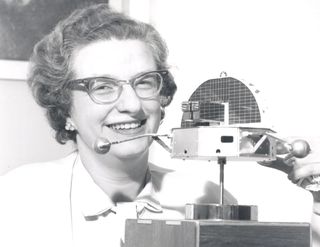Space History Photo: Dr. Nancy Roman

In this historical photo from the U.S. space agency, Dr. Nancy Roman, one of the nations top scientists in the space program, is shown in 1963 with a model of the Orbiting Solar Observatory (OSO).
Roman received her Ph.D. in astronomy from the University of Chicago in 1949. In 1959, she joined NASA and in 1960 served as Chief of the Astronomy and Relativity Programs in the Office of Space Science.
Roman was very influential in creating satellites such as the Cosmic Background Explorer (COBE) and the Hubble Space Telescope (HST). She retired from NASA in 1979, but continued working as a contractor at the Goddard Space Flight Center.
Throughout her career, Dr. Roman was a spokesperson and advocate of women in the sciences. NASA today has a web site devoted to highlighting women who work at the agency, with one goal being to “inspire girls everywhere to reach for the stars and explore the myriad of opportunities available to them through pursuing careers in science, technology, engineering and mathematics.”
Each weekday, SPACE.com looks back at the history of spaceflight through photos (archive).
Get the Space.com Newsletter
Breaking space news, the latest updates on rocket launches, skywatching events and more!
Join our Space Forums to keep talking space on the latest missions, night sky and more! And if you have a news tip, correction or comment, let us know at: community@space.com.

The National Aeronautics and Space Administration (NASA) is the U.S. government agency in charge of the civilian space program as well as aeronautics and aerospace research. Founded in 1958, NASA is a civilian space agency aimed at exploring the universe with space telescopes, satellites, robotic spacecraft, astronauts and more. The space agency has 10 major centers based across the U.S. and launches robotic and crewed missions from the Kennedy Space Center in Cape Canaveral Florida. It's astronaut corps is based at the Johnson Space Center in Houston. To follow NASA's latest mission, follow the space agency on Twitter or any other social channel, of visit: nasa.gov.
